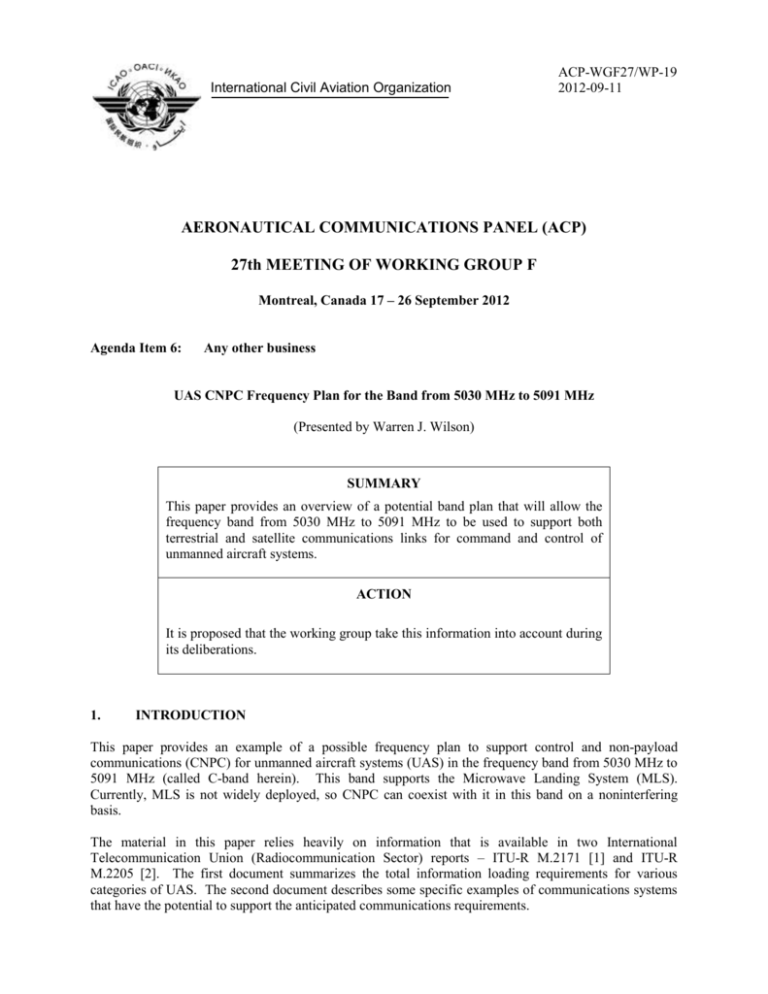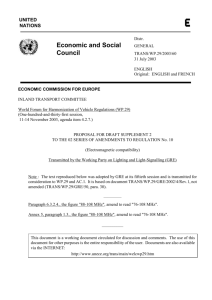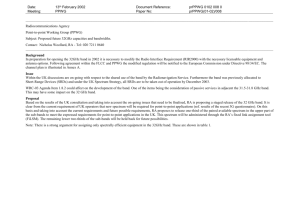ACP - ICAO
advertisement

International Civil Aviation Organization ACP-WGF27/WP-19 2012-09-11 AERONAUTICAL COMMUNICATIONS PANEL (ACP) 27th MEETING OF WORKING GROUP F Montreal, Canada 17 – 26 September 2012 Agenda Item 6: Any other business UAS CNPC Frequency Plan for the Band from 5030 MHz to 5091 MHz (Presented by Warren J. Wilson) SUMMARY This paper provides an overview of a potential band plan that will allow the frequency band from 5030 MHz to 5091 MHz to be used to support both terrestrial and satellite communications links for command and control of unmanned aircraft systems. ACTION It is proposed that the working group take this information into account during its deliberations. 1. INTRODUCTION This paper provides an example of a possible frequency plan to support control and non-payload communications (CNPC) for unmanned aircraft systems (UAS) in the frequency band from 5030 MHz to 5091 MHz (called C-band herein). This band supports the Microwave Landing System (MLS). Currently, MLS is not widely deployed, so CNPC can coexist with it in this band on a noninterfering basis. The material in this paper relies heavily on information that is available in two International Telecommunication Union (Radiocommunication Sector) reports – ITU-R M.2171 [1] and ITU-R M.2205 [2]. The first document summarizes the total information loading requirements for various categories of UAS. The second document describes some specific examples of communications systems that have the potential to support the anticipated communications requirements. -2- ACP WG-F27/WP-19 The examples comprise a satellite beyond-line-of-sight (BLOS) system operating in C-band and a terrestrial line-of-sight (LOS) system operating in both C-band and the band from 960 MHz to 1164 MHz. (Further detailed information on the candidate architecture can be found in reference [3].) This paper focuses on the satellite system and the C-band aspects of the terrestrial system. 2. DISCUSSION In this section the satellite C-band frequency plan and the terrestrial C-band plan are discussed separately. The plans are based to a large extent of the information found in references [2] and [3]. The plans have been slightly modified in order to coordinate their usage of the band with each other and with MLS. Note that the MLS is organized into 300 kHz channels so that, for example, channel 500 corresponds to 5031 MHz and channel 698 corresponds to 5090.4 MHz (see reference [4]). In general, the relationship between the MLS channel number (N) and frequency (F) (in MHz) is as follows: F = 4881 + 0.3 N It is assumed in this paper that the MLS frequencies so defined are the center frequencies of their respective channels. 2.1 Satellite System Frequency Plan Details of the satellite system design can be found in Annex 2 of reference [2]. Only a brief summary is provided here. The geometry of the links is shown in Figure 1. The complete path from the pilot to the satellite to the UA (consisting of paths 1 and 2) is designated as the forward link, and the complete path from the UA to the satellite to the pilot (consisting of paths 3 and 4) is the reverse link. In order to eliminate potential cosite interference issues on board the UA, access to forward and reverse links is half duplex. In other words, each UA can receive on the forward link half the time and transmit on the reverse link the other half. Efficiency is not necessarily reduced due to the half-duplex approach since a nearby UA can receive and transmit on the same frequencies in the reverse time slot order. Figure 1. Satellite Link Geometry Due to an asymmetry in the loading requirements for the forward and reverse links, the bandwidth allocated to reverse links is four times the bandwidth allocated to forward links. (Although the description of the satellite system in reference [2] does not show how the specific bandwidths are derived; their ratio seems reasonable given the ratio of forward and reverse link requirements.) Thus, 46 300-kHz channels are split into two to provide 92 150-kHz reverse “path 3” channels, and 11.5 300-kHz channels are split into eighths to provide 92 37.5-kHz forward “path 1” channels. These channels are received by -3- ACP-WGF27/WP -19 the satellite in the band from 5073 MHz to 5090.25 MHz. The satellite then down-converts these receptions by 42 MHz so that it transmits 92 150-kHz reverse “path 4” channels and 92 37.5-kHz forward “path 2” channels – occupying the band from 5031 MHz to 5048.5 MHz. This arrangement is shown pictorially in Figure 2. The number in each rectangle corresponds to the link shown in Figure 1. Clearly, there is a 24.75-MHz band from 5048.25 MHz to 5073 MHz that is not used by the satellite system; that band is used by the terrestrial C-band system described below. 3.45 M 2 24.75 MHz 13.8 MHz 3.45 M Terrestrial 4 1 13.8 MHz 3 5090.25 MHz 5031 MHz Figure 2. Satellite Link Frequency Plan 2.2 Terrestrial System Frequency Plan The geometry of the terrestrial system is shown in Figure 3. The proposed communications architecture outlined in references [2] and [3] is based on a combination of time division duplex (TDD) and frequency division multiple access (FDMA). As in the satellite architecture each UA alternates between time slots for reception and transmission. To accommodate the asymmetry in loading requirements, the slots supporting the forward links (path 1) are shorter than those supporting the reverse links (path 2). In this terrestrial architecture all forward link transmissions are aligned in one set of slots and all reverse link transmissions are aligned in a completely separate set of slots. The purpose of this arrangement is to eliminate all interference between forward and reverse links. UA 1 2 Pilot Figure 3. Terrestrial Link Geometry The terrestrial system is assumed to be cellular, with frequency sets being reused in a 12-cell pattern. The cell size is chosen so that there are (on average) 10 UAS in each cell (based on population estimates found in reference [1]). In order to take into account statistical fluctuations in the number of users, each cell is provisioned to support up to 20 users. Since the architecture is based on FDMA, this means that each cell uses 20 separate frequency channels. One final feature that affects the terrestrial frequency plan is that the architecture supports a limited number of UA that downlink airborne weather-radar and/or video information. To provide these capabilities the 20 channels in each of 12 cell types comprise the following: 12 channels, each with 37.5 kHz bandwidth, to support basic command and control information transmission (12 x 12 x 0.0375 MHz = 5.4 MHz) -4- ACP WG-F27/WP-19 4 channels, each with 75 kHz bandwidth, to support basic and weather radar information transmission (12 x 4 x 0.075 MHz = 3.6 MHz) 4 channels, each with 300 kHz bandwidth, to support basic, weather and video information transmission (12 x 4 x 0.3 MHz = 14.4 MHz) The fact that the bandwidth of the terrestrial basic channels (37.5 kHz) is the same as the bandwidth of the reverse channels in the satellite design is purely coincidental. Also, note that the actual information throughputs are not proportional to these bandwidths and depend on a number of factors including modulation type, time-slot size, error coding, other overheads etc. This terrestrial frequency plan is shown pictorially in Figure 4. Guard 5.4 MHz 3.6 MHz 14.4 MHz 5072.55 MHz 5048.55 MHz Basic Basic + Weather Basic + Weather + Video Figure 4. Terrestrial Link Frequency Plan 2.3 Overall Frequency Plan in Terms of MLS Channels The overall disposition of frequencies is tabulated in Table 1, using an extended version of the MLS channel numbering system. If the MLS channel numbered N is split in two, the lower and upper halves are designated NA and NB, respectively. Similarly, if the channel is split into fourths, the designations are Na, Nb, Nc and Nd. Finally, if the channel is split into eighths, the resulting channels are N 1 through N8. The third and fourth columns indicate whether the channels are part of the satellite or terrestrial system and (in each case) how the channels fit into either architecture. The letter “G” in the right hand column means that the listed frequencies are used as guard bands. The size of the guard bands between the different modulation types has been liberally set to be 300 kHz. This is just an educated estimate of what is required. A more refined determination would require more details regarding the transmitter spectral masks, receiver selectivities, modulation types etc. that have not been defined. In any case, the total amount of guard listed in Table 1 is 1.5 MHz, which is a relatively small fraction of the total bandwidth in question, 61 MHz. Thus, the results of this paper would not be greatly modified if the guard requirements changed somewhat. -5- ACP-WGF27/WP -19 Table 1. Proposed Satellite and Terrestrial Channel Usage MLS Channel Numbers 5001 to 5004 5005 to 5118 512A to 557B 558 5591 to 5768 577 578a to 589d 590 591 to 638 639 6401 to 6404 6405 to 6518 652A to 697B 698 Frequency Subband (MHz) 5030.85 – 5031.00 5031.00 – 5034.45 5034.45 – 5048.25 5048.25 – 5048.55 5048.55 – 5053.95 5053.95 – 5054.25 5054.25 – 5057.85 5057.85 – 5058.15 5058.15 – 5072.55 5072.55 – 5072.85 5072.85 – 5073.00 5073.00 – 5076.45 5076.45 – 5090.25 5090.25 – 5090.55 BLOS Link LOS Link Bandwidth Guard G 2 4 G 37.5 kHz G 75.0 kHz G 300 kHz G G 1 3 G Note that the total bandwidth allotted to the satellite system in the C-band is 34.5 MHz (from 5031 MHz to 5048.25 MHz and from 5073 MHz to 5090.25 MHz). It should be pointed out that the bandwidth discussed in reference [2] is somewhat higher (about 40 MHz), but that analysis did not address the need to share the band with a terrestrial CNPC system. The total bandwidth for the terrestrial system is 24 MHz (from 5048.55 MHz to 5072.55 MHz – including 0.6 MHz for guard bands). The terrestrial system was estimated in reference [1] to require a total bandwidth of about 34 MHz. The remaining 10 MHz may be available in the lower portion of the 960 MHz to 1164 MHz band. The estimated bandwidth requirement for the satellite system was 56 MHz. The location of the remaining satellite bandwidth is still to be determined. 2.4 Design Flexibility The frequency plan embodied in Table 1 is a specific, preliminary example; the ultimate frequency plan might result in a different split between satellite and terrestrial bandwidth. Such an adjustment can be easily accommodated. For instance, if the bandwidth requirement for the satellite system is reduced, the size of the terrestrial allotment in the center of Figure 2 can be increased. That central bandwidth can be used by the terrestrial system to provide more communications capacity. The extra capacity could be used in a number of ways including (but not limited to) providing more channels per cell and/or providing more high-bandwidth channels per cell. 3. ACTION BY THE MEETING This paper provides an overview of a potential band plan that will allow the frequency band from 5030 MHz to 5091 MHz to be used to support both terrestrial and satellite communications links for command and control of unmanned aircraft systems. In order to avoid delays to development of either link, the above band plan is proposed. It should be emphasized that the architectures discussed herein are examples of systems that might support CNPC, so they serve as useful artifacts for discussing, in a concrete way, issues such as frequency ACP WG-F27/WP-19 -6- planning. Nevertheless, this paper shows that for the chosen architectures the 5030–5091 MHz frequency band can simultaneously support about 70% of the requirements of the terrestrial system and about 60% of the satellite bandwidth requirements. The remainder of the estimated terrestrial and satellite requirements will have to be satisfied in one or more other bands. It is proposed that the working group take this information into account during its deliberations. 4. REFERENCES [1] International Telecommunication Union, “Characteristics of unmanned aircraft systems and spectrum requirements to support their safe operation in non-segregated airspace,” ITU-R Report M.2171, December 2009. [2] International Telecommunication Union, “Results of studies of the AM(R)S allocation in the band 960 – 1 164 MHz and of the AMS(R)S allocation in the band 5 030 – 5 091 MHz to support control and nonpayload communications links for unmanned aircraft systems,“ ITU-R Report M.2205, November 2010. [3] Wilson, Warren J., “Strawman Design for Terrestrial Unmanned Aircraft Control Links,” International Communications, Navigation and Surveillance Conference (ICNS 2011), Herndon VA, May 10 – 12, 2011. [4] Federal Aviation Administration, “Spectrum Management Regulations and Procedures Manual,” FAA Order 6050.32B, 17 November 2005, App. 3.





